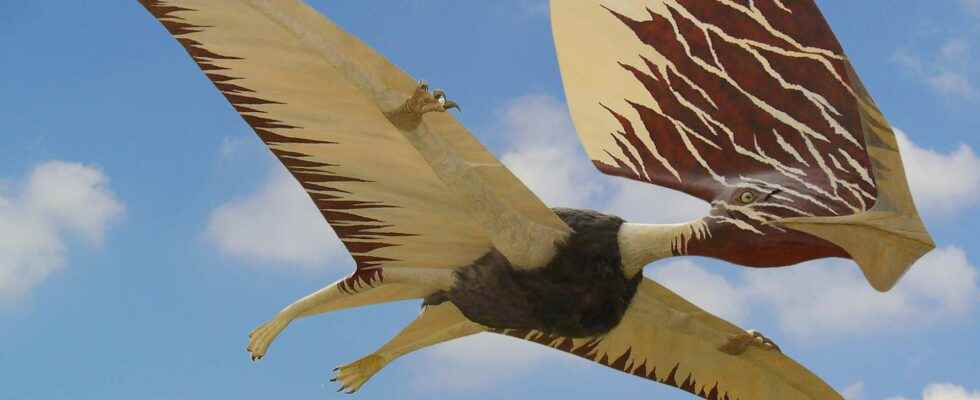Pterosaurs, these flying reptiles that populated the Earth at the same time as the dinosaurs, disappeared 66 million years ago, during the impact of a giant asteroid. Thanks to the analysis of a fossil, researchers have shown that not only were they feathered, but that their plumage took on different colors!
You will also be interested
[EN VIDÉO] Interview: Are birds the last descendants of dinosaurs? With the multiple discoveries of feathered dinosaurs in China, the question arises of the link with birds. Could these be the descendants of these extinct creatures? Futura-Sciences interviewed Éric Buffetaut, paleontologist, to find out more about the issue.
Present during themesozoic erabetween 230 million years and 66 million years ago, the pterosaurs were flying reptiles. They died out at the same time as the dinosaurs when a asteroid giant hit the Earth. Devoid of descendants, all the data of the researchers are based on discoveries of fossils still well preserved, very rare.
But a debate about these reptiles ruffles made rage among the scientific community: were they furry or feathered? A study published in the journal Nature April 21, 2022 finally answered the question, in which researchers not only demonstrated that these prehistoric reptiles were indeed feathered, but also that these were of different colors !
Like some dinosaurs, these pterosaurs were feathered
To obtain these results, they analyzed in detail a fossil of Tupandactylus imperatora species of pterosaur dating from 115 million years ago. Preserved on five slabs of limestone from the Lower Cretaceous Crato Formation in northeastern Brazil, it is more precisely the crest of this pterosaur that they passed to the microscope.
They deduced its integumentary structure, that is to say the border which separates the inside of the body from the outside (for humans for example, it is the skin). This has a series of ramifications, the appearance of which differs according to the place on the crest: but even more, their internal structure is similar to those of the feathers of birds, which consists of a spine – a central bar – and barbs that extend on each side of the spine. “This mode of branching is directly comparable to that of stage IIIa feathers of extant birds”deduce the researchers in the study.
After proving the presence of feathers, the team then studied their composition in detail with electron microscopes at high power: more precisely, they analyzed “soft tissue samples from the fossil monofilaments, branching feathers, and fibrous soft tissues of the cranial crest”, as detailed in the study. They found many melanosomes preserved, organelles which synthesize the melaninspigments widespread in living organisms.
Several melanosomes for several types of feathers
Scanning electron microscopy showed abundant ovoid or elongated microbodies approximately 0.5-1 μm in length. Those microorganisms called melanosomes correspond according to the study to “degraded remnants of the matrix of keratin feathers “. However, each specific form of melanosome corresponds to a different color. They thus concluded that the pterosaurs had feathers of many colors. Their location on the crest further suggests that these feathers were used for visual communication, as with many species ofvery colorful current birdsbecause they are of no use for theft.
“In modern birds, feather color is strongly related to the shape of the melanosome, said Professor McNamara, co-author of the study and researcher at the University of Cork in Ireland. Since different types of pterosaur feathers had different forms of melanosomes, these animals must have had the machinery genetic to control the colors of their feathers. This characteristic is essential for color structuring and shows that coloring was an essential characteristic even of the very first feathers. »
Their research puts an end to decades of doubts
With this research, the team puts an end to decades of doubts about the presence of feathers in pterosaurs. “We didn’t expect to see this at all.said Dr Cincotta, first author of the study and researcher at University College Cork. For decades, the paleontologists argued over whether pterosaurs had feathers. The feathers of our specimen definitively close this debate because they are very clearly branched along their entire length, just like today’s birds. » Today, the fossil has finally returned to its original location, i.e. Brazil.
Interested in what you just read?
